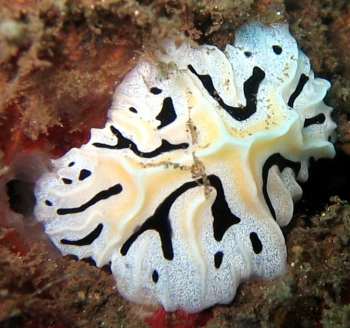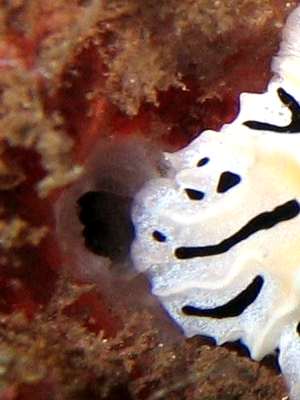Reticulidia fungia from Bali
January 2, 2005
From: Rainer Mau


Dear Bill,
The picture of the attached species was taken during a dive in the waters off north-east Bali, precisely at the house reef of the small resort Alam Anda.
In the book Nudibranchs of the South Pacific, Vol 1, by Neville Coleman, the species has the common name "Abstract Phyllidia", however, no scientific name is cited.
Locality: House reef, Alam Anda, Bali, Indonesia, Java Sea
Depth: 18 meters. Length: 20 mm. 16 December 2004
House reef below coral head
Photographer: Rainer Mau
Your help is really appreciated.
Cheers
Rainer
rainer.mau@hansenet.de
Mau, R., 2005 (Jan 2) Reticulidia fungia from Bali. [Message in] Sea Slug Forum. Australian Museum, Sydney. Available from http://www.seaslugforum.net/find/12875
Dear Rainer,
This is Reticulidia fungia. At the time Neville's book was published it did not have a scientific name. 'Common names' in photo books like this are a bit of a misnomer. They are 'common' in the sense they use 'common' everyday English. They are certainly not 'common' in the sense they are commonly used for the species. In fact the common names were made up for that book. 'Common names' are not very helpful because they differ from book to book. I would encourage you to use scientific names - where they exist - because they are understood worldwide and so are the real 'common name' for each species.
Your animal is a particularly pale form of the species, the yellow being quite pale and the black region reduced to bands. Your lower photo, which I have included a close-up of alongside, is also very interesting because it shows a hole in the reddish sponge which looks like it could have been eaten out by the nudibranch. The family Phyllidiidae, to which Reticulidia belongs, have no teeth or hard parts to assist in feeding, the animals feeding by dissolving the sponge tissue externally and sucking the half-digested soup into their mouth. I suspect the hole you can see is a burrow or some other natural phenomenon, but the bare whitish tissue you can see appears to be damaged sponge tissue. An interesting observation, because we know so little about feeding in these animals, and nothing about feeding in this species.
Best wishes,
Bill Rudman
Related messages
-
Reticulidia fungia from Ningaloo Reef West Australia
From: Chris Cunnold, May 24, 2006 -
Re: Reticulidia fungia from Bali
From: Rainer Mau, January 27, 2005 -
Re: Reticulidia fungia from Vanuatu
From: Nick Hobgood, June 21, 2004 -
Colour variation in Reticulidia fungia from Philippines
From: Fredy Brauchli, June 10, 2002 -
Reticulidia fungia from Christmas Island
From: W.B. Rudman, May 10, 2002 -
Reticulidia fungia from the Solomon Islands
From: Mary Jane Adams, February 4, 2001 -
Reticulidia fungia from the Solomon Ids
From: Bruce Potter, October 16, 2000 -
Reticulidia fungia variation from Marshall Ids
From: Scott Johnson, December 9, 1999 -
Reticulidia fungia from Vanuatu
From: Vinka Stenhouse, November 28, 1999
